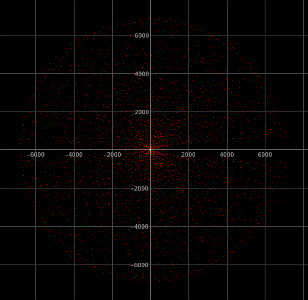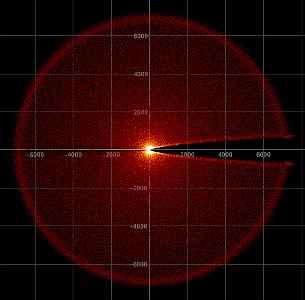
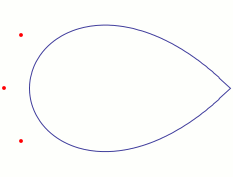

Remarkable properties of
roots of polynomials
This is a set of experiments, using advanced software for finding zeros of polynomials. First it is briefly explained what is meant with the word "polynomial". Next, the concept of polynomial equations is introduced, and finally, different types of polynomials are explored and some beautiful patterns of roots of polynomial equations are shown. An example is given in the picture below of the complex zeros of a 1000th degree polynomial. The software, used for the experiments, described in this web page, is available in source code format and can be compiled for Linux, Windows, and ARM systems like the Raspberry PI or Odroid C1, and Odroid C2.
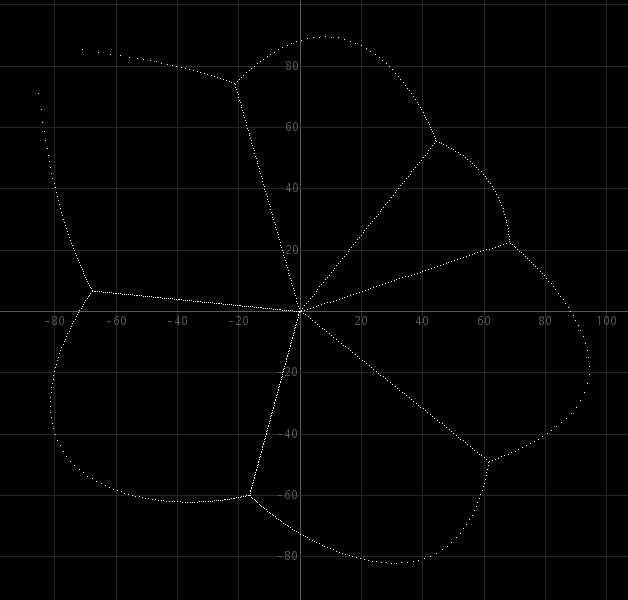
For people with somewhat more mathematical background, the first few paragraphs of this webpage may be dull and full of trivial contents, but the introduction to polynomials is added so that everyone with knowledge of upper level high school mathematics can understand what happens in this web page.
What is a polynomial?
The word "polynomial" is a strange word derived from two languages, which first appeared in the 17th century. It is a combination of the Greek word "poly" and the Latin word "nomen". This makes its literal translation "multiple names".
In mathematics, a polynomial is an expression, consisting of terms, where each term is a non-negative integer power of some variable or unknown, multiplied by a constant. A few examples of polynomials are given below:
- polynomial in one variable x : 5x2 + 10x − √2
- polynomial in two variables x and y
: −5x2y3 + x4 − π xy +
17
As the examples show, the constant factors may be anything, as long as they do not depend on the variables in which the polynomial is expressed.
This web page is about polynomials in a single variable. This kind of polynomial is called univariate polynomial.
A polynomial can be regarded as a mathematical function, which only contains integer powers of the argument of the function. The univariate example, given above can be written as
p(x) = 5x2 + 10x − √2
The degree of a univariate polynomial is the highest power of the variable which appears in the expression. In this example, the highest power is 2, hence the degree of that polynomial is 2.
A general expression for an nth degree univariate polynomial in variable x is
a0 + a1x + a2x2 + . . . + anxn, where a0, a1, a2, etc. are constants. These constants are called coefficients. Terms with coefficients equal to 0, usually are not written. E.g. 5 + x3 is a 3th degree polynomial with coefficients a0=5, a1=0, a2=0, a3=1. The order in which terms appear in a polynomial does not matter. Sometimes people write polynomials with highest powers at the end, other times they write polynomials with highest power first. A 0th degree polynomial is simply a constant.
Polynomials can be defined over any field.
This webpage restricts itself to polynomials over the
field of real
numbers or the field of complex numbers. A polynomial
over the field of
real numbers has real coefficients, a polynomial over
the field of
complex numbers can have real coefficients, but it also
may have
complex coefficients.
Zeros of polynomials
A zero of a polynomial p(x) is a value x0, which can be substituted for x, such that p(x0) equals 0. Sometimes such a number also is called a root. For example, the roots of the equation x2 − 5x + 6 = 0 are the numbers 2 and 3. These numbers are called the zeros of the polynomial x2 − 5x + 6. A polynomial over the field of real numbers does not need to have any real zeros. E.g. the polynomial x2 + 1 has no real zeros. There is no real x, which can make x2 + 1 equal to 0. Finding real zeros of low degree polynomials with real coefficients can be done graphically, by drawing the graph of the function p(x).
A polynomial also can have a so-called multiple zero. This means that it has zeros of the same value. What is meant with multiple zero (in this case a double zero) is demonstrated by a simple graphical example.
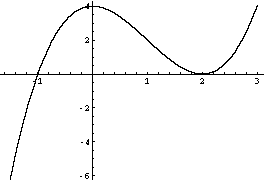
Here you see the graph of p(x) = x3 − 3x2 + 4. This polynomial has two distinct zeros, one being equal to −1, the other being equal to 2. The zero at 2, however is a double zero. The graph passes through the x-axis at x=−1. At x=2 it just touches the x-axis. Imagine another polynomial q(x) with the graph of p(x) moved down a tiny amount ε: q(x) = p(x) − ε = x3 − 3x2 + 4 − ε. You see that the double zero 2 splits up in two distinct zeros 2−δ1 and 2+δ2, where δ1 and δ2 are small amounts, depending on the precise value of ε (for very small ε, δ1 ≈ δ2 ∼ √ε). The zero at −1 also changes slightly, but it remains single. When the graph of p(x) is shifted upwards, then the double zero at 2 disappears and only a single zero near −1 remains.
A full understanding of the roots of polynomial equations only is possible when one is working in the field of complex numbers. It goes too far to explain complex numbers in this webpage. A good introduction to complex numbers can be found on internet, e.g. https://en.wikipedia.org/wiki/Complex_number.
In the field of complex numbers the
above example can be understood better. When the graph
is shifted upwards a tiny amount ε the double zero at 2 splits into two
distinct complex zeros, which for very small ε can be approximated well as 2−δi and 2+δi, with
δ ∼ √ε.
So, in the field of complex numbers, the total number of
zeros is equal
to 3, regardless of how much the graph is shifted. We
either have 3
distinct real zeros, one real zero and one real double
zero, or one
real zero and two complex zeros. The total number of
zeros, however,
always equals 3. The situation with the double zero is a
borderline
situation. Distinct zeros have a so-called multiplicity. A
normal (single) zero has multiplicity 1, a double zero
has multiplicity 2, a triple zero has multiplicity 3,
and so on.
Fundamental theorem of algebra
In the field of complex numbers, in general a polynomial of degree n has at most n distinct zeros, but if the multiplicity of zeros is taken into account, then a polynomial of degree n has exactly n zeros. This is a very important theorem, and it is called the fundamental theorem of algebra. Keep in mind though that this only is true in the field of complex numbers. In the field of real numbers, the number of zeros may be less than the degree of the polynomial and in other fields the number of zeros also may be less.
Any polynomial over the complex numbers can be written in product-form if its zeros x1, x2, . . ., xn are known.
p(x) = a0 + a1x + a2x2 + . . . + anxn = an (x−x1)(x−x2) . . . (x−xn)
Some of the zeros may have the same
value, in that case we have a multiple zero. The example
polynomial x3 − 3x2 + 4
can be written as (x+1)(x−2)(x−2).
Finding the zeros of polynomial
equations
The fundamental theorem of algebra only states something about the existence of zeros, it does not tell anything on how to find the roots of polynomial equations. For first degree and second degree polynomials, finding the zeros is easy. This is thought at high school. It also is possible to provide expressions for the roots of 3th degree and 4th degree polynomial equations, in terms of √, ∛, ∜ and the arithmetic operations +, −, ∙, and /. For higher degree polynomials no general formula in terms of nth-roots and basic arithmetic operations exists. It is not a matter of not yet having discovered such a formula for e.g. 5th degree polynomials, but it is proven that no such formula can exist for general polynomials of 5th or higher degree. Understanding that kind of proof is beyond high-school mathematics and only a reference is given here: https://en.wikipedia.org/wiki/Abel%E2%80%93Ruffini_theorem.
Just for fun, the formula for second
degree
and third degree polynomials is given here for
comparison. The formula
for one of the zeros of a general fourth degree
polynomials is insanely
complicated and would fill many pages.
The zeros of the second degree polynomial ax2 + bx + c can be written as

One of the zeros of the third degree
polynomial ax3 + bx2 + cx + d can be written as

The formula for the third degree
equation
only gives one zero, the one which always is real for
real coefficients
a, b, c, and d. For the other two zeros there are
similar but somewhat
more complicated expressions. If the third degree
equation has three
real roots, then the above formula has a real value, but
the two cube
root terms are complex. The imaginary parts of these
terms cancel
exactly. A nice page, which also gives a good derivation
of the
expressions for roots of third degree polynomial
equations, can be
found on Wikipedia: https://en.wikipedia.org/wiki/Cubic_function.
Numerical approximation of zeros of
polynomials
As stated above, there is no general
applicable formula, which gives the roots of any given nth-degree
polynomial
equation. It, however, is possible to find numerical
approximations of the zeros of polynomials. For low
degree polynomials
with real coefficients, one can draw a graph and find
estimates of the
real roots. This is nice for high school mathematics and
can be done on
modern graphical calculators, but for general unattended
root-finding
this method is not very useful.
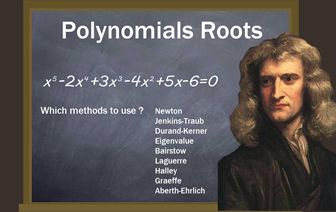
In the last decades a lot of
research-effort is put in finding reliable methods for
approximating
roots of general polynomial equations. This has proven
to be a
remarkably difficult task. Nearly all algorithms,
developed over the
last 100 years, work for many polynomials, while they
fail miserably
for many other polynomials. Only recently, really
fool-proof
algorithms became available. A really amazing algorithm
is the 2012 incarnation of the MPSolve
algorithm by Dario A. Bini and Leonardo Robol.
Also from Bini, there is a Fortran implementation of
1996 of a limited
precision implementation of a much older version of the
MPSolve
algorithm. There also are much-praised algorithms from
M.A. Jenkins and
J.F. Traub, implemented in Fortran around 1970. Some of
these
algorithms I ported to C and
to Java and for the 2012 MPSolve algorithm I developed a
so-called JNI
interface so that my implementation in C
becomes available from Java-programs on PC's running
under Windows or
Linux. There also is a JNI implementation for 32-bit and
64-bit ARM
architectures (e.g. Raspberry PI, Odroid, Orange PI).
The source code
and instructions
for how to compile and run these programs are given in a
separate page:
software.html.
Bini
and Robol themselves also provide an implementation of
their 2012
MPSolve algorithm, but this implementation has many bugs
(a lot of
memory leaks and a completely borked piece of code for
estimating the
accuracy of the results obtained so far). This not so
good
implementation, however, also makes clear how robust
their mathematical
algorithm is. Even with a buggy implementation, which
sometimes
completely screws up computed intermediate
approximations, the
algorithm still gives good results, albeit at higher
computational
cost. I created an implementation, loosely based on
Bini's and Robol's
code, but it is (as far as I know) free of memory leaks
and much faster
for high precision output calculations.
The 1996 MPSolve algorithm and the Jenkins and Traub algorithm use standard floating point arithmetic with double precision of 53 bits, or a double double precision of 105 bits, which is made available for both C and Java through a fairly simple set of functions/methods. The 2012 MPSolve implementation uses GMP, a multi-precision library, and allows computations at very high precision (thousands of bits is not uncommon) at the cost of higher computation time. The code, using 53-bit or 105-bit precision can be used to solve polynomial equations of degree up to 50 or so, having not too difficult configurations of roots (e.g. tight clusters of roots, or multiple roots). A single double root or even triple root, well separated from the other roots, however, can be handled by that code.
The implementation of the 2012 MPSolve
algorithm can be used to find zeros of polynomials of
degrees 10000 or
even higher if you are patient. This software has no
problem with tight clusters
of roots, many multiple roots and other extremely
ill-conditioned
problems. Up to now, I could not find a single
polynomial equation,
which could not be solved by the 2012 MPSolve
implementation! This
program is very interesting for exploring extremely high
degree
polynomials.
The algorithms behind the software are beyond the scope of this webpage, but in the software itself, there is extensive documentation and there also are copies of relevant papers. This webpage from now on emphasizes on exploring some interesting classes of polynomial equations.
![]()
Exploration of truncated power
series of exponential functions
The exponentional function f(x) = ex has no zeros. The Taylor series of this function is as follows:

This series has no zeros, but what if the series is truncated? We can obtain a polynomial of nth degree by truncating this series after the term with power n. The truncated power series can be written as

According to the fundamental theorem of algebra, this truncated series has exactly n solutions in the complex plane. For n going to infinity, the number of zeros of the truncated power series equals n. Here we seem to have a paradox, because f(x), which is f∞(x) has no zeros, while we expect it to have ∞ zeros. This interesting seemingly paradoxical situation can be investigated by approximating the solutions of fn(x) for increasing values of n. Below follows an animated GIF image of the zeros of the truncated power series of fn(x) for n ranging from 10 to 1000. As the animation shows, for increasing n, the magnitude of the zeros increases.
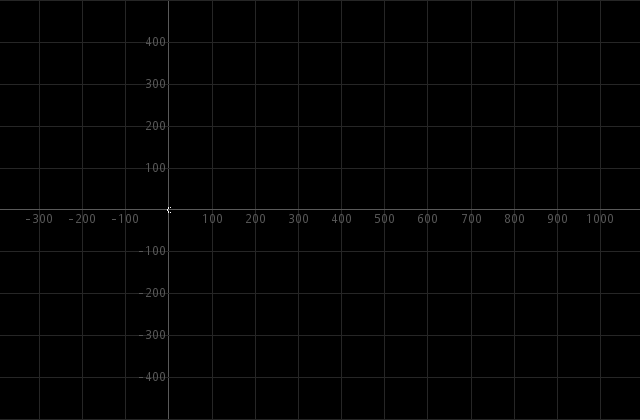
What if n goes to infinity? Because of
the
fact that f(x), the infinite series, has no zeros, one
could conclude
that the zeros go to infinity as well. Another test is
done to confirm
this. I also made an animation, for which the zeros of fn(x)
were
approximated and then these zeros, divided by n, were
plotted in
the image. So, the zeros are scaled down with the value
of n, for which
the power series is truncated. A link to this animation
is given here: zeros of fn(x), divided by
n.
This animation shows that the zeros, divided by n, seem
to converge to
points on a certain curve. This is strong evidence for
the hypothesis
that the roots of the truncated power series fn(x)
go to infinity if n goes to infinity. The exponential
function hence has an infinite number of zeros at
infinity!
The fact that the scaled zeros of the truncated power series fn(x) converge to points on a certain curve is a very deep result. Even deeper is that an analytic expression is found for this curve. This great result is obtained in the 1920s by a hungarian mathematician, called Gábor Szegö. The zeros of the function fn(nx) converge to the curve ∣zez−1∣ = 1, where z is a complex number. In this paper a thorough derivation is given of this result. This curve nowadays is known as the Szegö-curve.
All zeros near the Szegö-curve
are an artifact of the fact that the power series is
truncated. As n is
increasing, the curve blows up (unscaled). This matches
with the fact that the equation ex
= 0 has no zeros. Next comes a very interesting
observation, about general equations ex
− p(x) = 0, with p any polynomial of x.
Generalized exponential equations of the form ex − p(x) = 0
No analytical expressions can be given
for the solutions of the generalized equation ex
− p(x) = 0, with p a polynomial of x. For constant (0th degree)
polynomials a0, this equation can be solved.
There are infinitely many solutions in the complex
plane, which can be written as ln(a0) + 2kπi
for any integer value of k. What happens with the zeros
of the truncated power series of ex
− a0? Below, the solutions are shown for a
constant polynomial p(x) = a0 = 1.
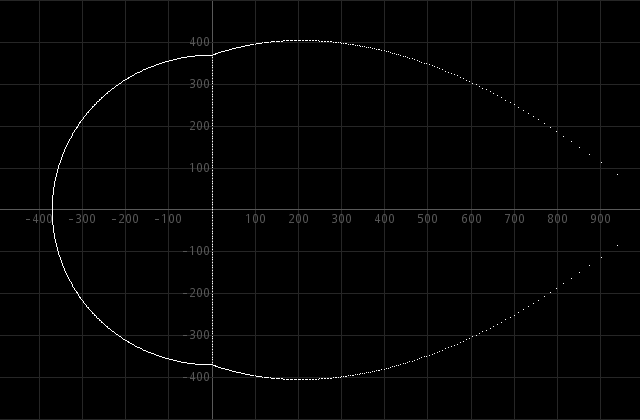
This image shows zeros at the imaginary axis, until the Szegö-curve is reached. At the left, the zeros are on a near-perfect half-circle, on the right, the zeros are near the Szegö-curve. When the numerical values of the zeros on the imaginary axis are inspected, then you see that up to many decimal places these zeros are close to 2kπi, the true zeros of the equation ex − 1 = 0.
When we do a similar computation for ex − x = 0, ex − x2 = 0, and ex − x10 = 0, then we get very similar results:
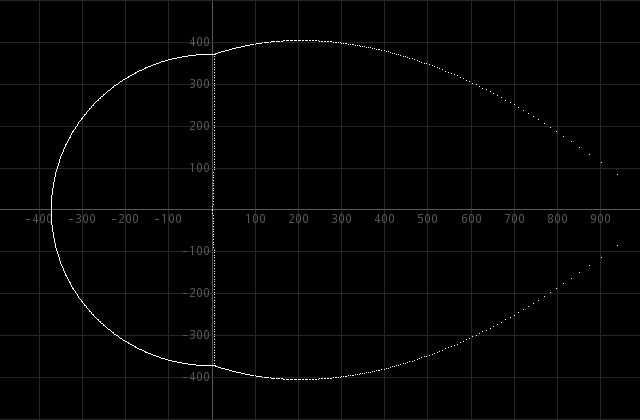
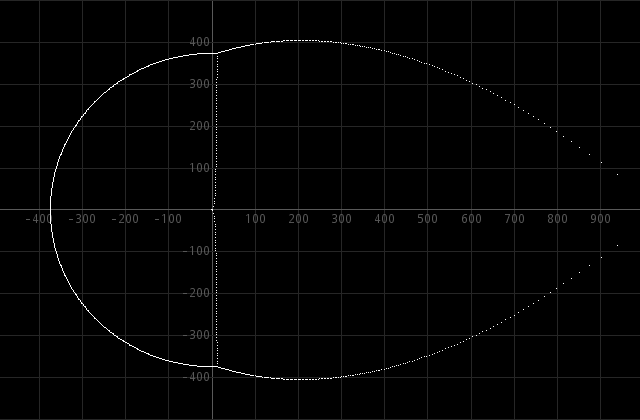
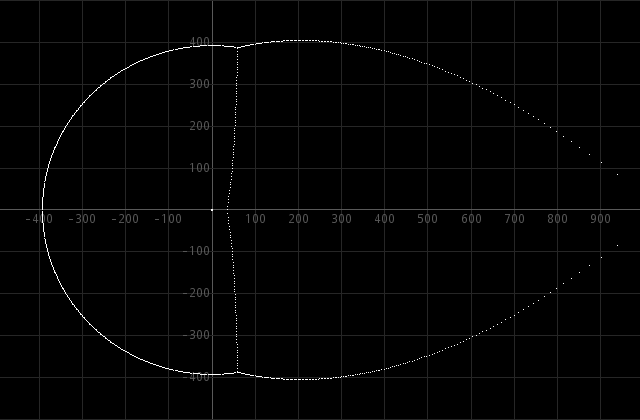
Further analysis shows that the roots near the imaginary axis are very close to the true roots of the equations ex − x = 0, ex − x2 = 0, and ex − x10 = 0.
Similar results also are obtained for
equations like ex − 5x = 0, ex
− ½x2 = 0, and ex
+ x10 = 0.
Also, when more complicated
polynomials are
used, the results are similar. The following shows the
result for the
truncated power series of ex − x30/30!
− x40/40! − x50/50! = 0. All zeros inside the outer curve are
very good approximations of the true zeros of the
untruncated function.
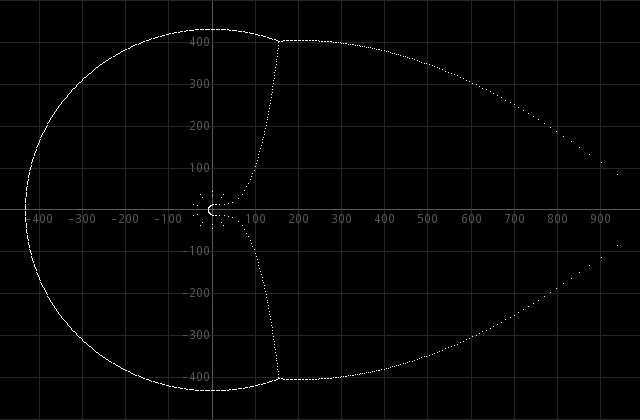
Finally, the effect of truncating at a larger power is shown. When the exponential function is truncated after the 1200th term, then one sees that the roots in the interior of the combined circle/Szegö curve are not affected, but the circle/Szegö curve is blown up and additional very good approximations of true roots of the equation are added to the set inside the circle/Szegö curve.
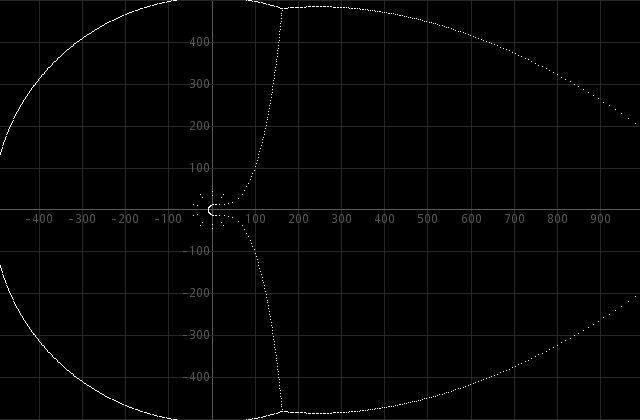
This behavior, as demonstrated above, allows us to approximate true zeros of equations of the form ex − p(x) = 0 simply by solving a truncated version for a certain n, such as n=1000, and solving a truncated version for a larger n (e.g. 10% larger). Roots, which are present in both sets (within an accuracy of 10 digits or so), are good approximations to true roots of this exponential equation, while the other roots are artifacts, due to the truncation of the power series of ex.
All images, shown above, were
generated
with the help of a C-implementation of the 2012 version
of the MPSolve
algorithm, using GMP for the required high precision
calculations.
Solving one polynomial equation of 1000th
degree took approximately 30 seconds on an Intel Core
i5, running at 3.4 GHz, in 4 threads, using all 4 cores
simultaneously.
A
complicated exponential equation
It turns out that similar behavior is obtained for more complicated exponential equations as well. In this experiment, a complicated equation is solved numerically and the obtained patterns are interesting. At the top of this webpage, the roots are shown of a truncated power series of the function


This complicated function can be written as a power series with complex coefficients. When this power series is trucated and the zeros of the resulting polynomials are determined, then the zeros at the interior are approximations of true zeros of this function, while the zeros on the outside are artifacts due to truncation of the power series. An in-depth study of this kind of sums of exponentials is given in this paper.
Using truncated power series of sine and cosine functions, one also can solve equations like sin(x) − x = 0 and cos(x) − x = 0. The functions sin(x) and cos(x) in fact are sums of exponential functions:

It is up to the reader of this page to
experiment with this kind of functions. One can solve
all kinds of
combinations of sines and cosines and one can combine
them with
polynomials. In the accompanying software suite, you can
find some
Java-code which can be used to experiment with the sine
and cosine
truncated power series.
![]()
Effect of random perturbations on zeros of polynomial
A completely different method for exploring polynomial equations is to investigate how zeros move through the complex plane when the coefficients of the polynomial are perturbed. In this experiment the starting point is a chosen set of zeros of a polynomial and from this, all coefficients are determined, using a computer program:
g(x) = (x − x1)(x − x2)(x
− x3)
. . . (x − xn)
=
a0 + a1
x + a2 x2
+ . . . + an−1 xn−1 + xn
Next, the coefficients are perturbed, and a perturbed polynomial is determined:
ĝ(x) = a0(1+ε0) + a1(1+ε1) x + a2(1+ε2) x2 + . . . + an−1(1+εn−1) xn−1 + (1+εn)xn
The perturbations are relative. If the perturbation εi equals
0.0001, then the coefficient ai
is perturbed after approximately the 4th digit. For many
polynomials,
such a small perturbation also leads to perturbations of
the zeros in
the same order of magnitude. For some polynomials,
however, small
perturbations of the coefficients lead to dramatic
changes of the zeros.
The polynomial (x-1)(x-2)(x-3-2i)(x-4)(x-5)(x-6)(x-7-6i)(x-8)2(x-10), which has complex coefficients, is used as a basis for the figures, shown below. The figures below are generated by first computing coefficients a0, a1, . . ., a9. The coefficients a10 equals 1. Starting from this polynomial, 2000000 random perturbed polynomials are created with ε0, ε1, ε2, . . . ε9, ε10, randomly chosen from an interval [-εmax, εmax]. The zeros of each of these polynomials are computed and each zero is used to increase the "heat" of a pixel in an image. Each time a pixel is touched by a zero, it is made a little "hotter". When the image is rendered, then pixels, which are never touched are cold and black. Very hot pixels are white. Intermediate pixels are shades of red, orange, yellow at increasing "temperature". This kind of images nicely shows which areas of the complex plane are hit frequently, and which areas are never hit.
Multiple images are generated for
multiple values of εmax:
εmax = ½·10−7 :
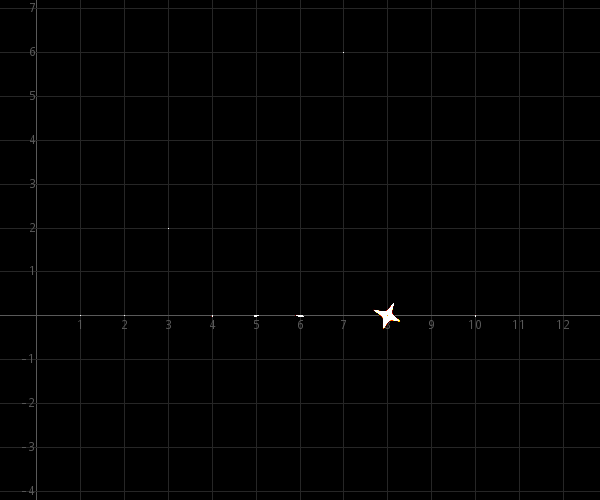
εmax = ½·10−6 :
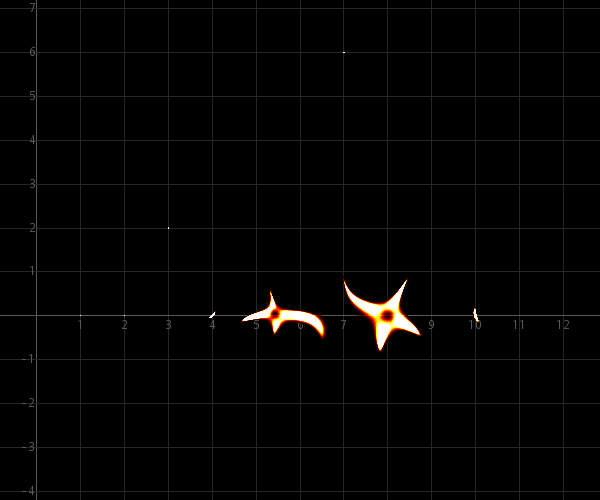
εmax = ½·10−5 :
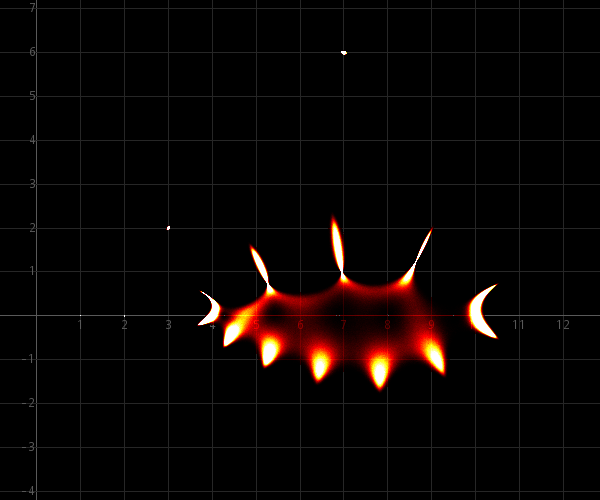
εmax = ½·10−4 :
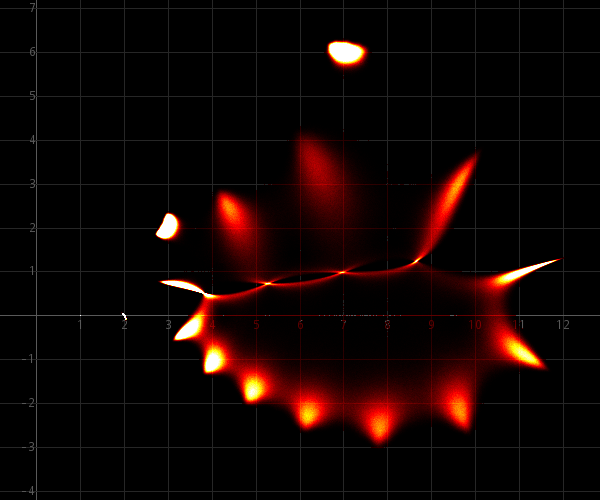
εmax = ½·10−3 :
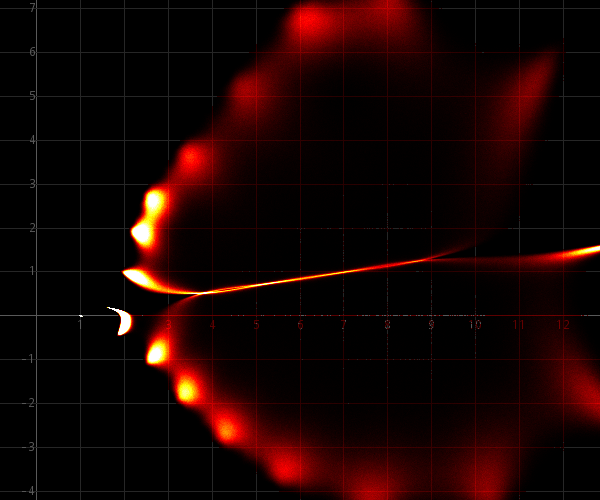
These images show intriguing patterns. The polynomial, used for this experiment, is nothing special, except that it has a double zero and that most of the zeros are on a line. This combination makes the polynomial very sensitive to perturbations.
An even more impressive demonstration
of
the behavior of the zeros of the polynomial under
perturbation is a
video, made from 81 images with εmax ranging from ½·10−7 to ½·10−3, where the exponent goes from −7 to −3 in steps of 0.05. This video can be
downloaded here.
In order to make this video, 1.62 billion 10th-degree
polynomial
equations were solved. This took nearly 70 minutes on an
Intel Core i5 processor, running at 3.4 GHz, in a single
thread. For
this purpose, a Java implementation of the 1996 version
of the MPSolve
algorithm was used in standard 53-bit IEEE floating
point precision.
Separate random perturbations on real and imaginary part of coefficients
It is interesting to see the effect of
using a slightly modified perturbation for the
polynomial, given above.
In the above situation, all perturbed coefficients âi
can be written as ai(1+εi), where the relative perturbations εi are real numbers. The same experiment is
done, where the real part and imaginary part of the
coefficients ai are perturbed independently. Suppose each
coefficient can be written as
where ui + vi are the real part and imaginary part of the coefficient ai.
Now the perturbed coefficient is written as
âi = ui (1+μi) + vi (1+νi) i,
where μi and νi
are random relative perturbations, computed
independently from each
other, both taken from a uniform random distribution in
the interval [-εmax, εmax].
This only is a subtle change from the experiment,
described above, where μi = νi.
Again, multiple images are generated
for multiple values of εmax:
εmax = ½·10−7 :
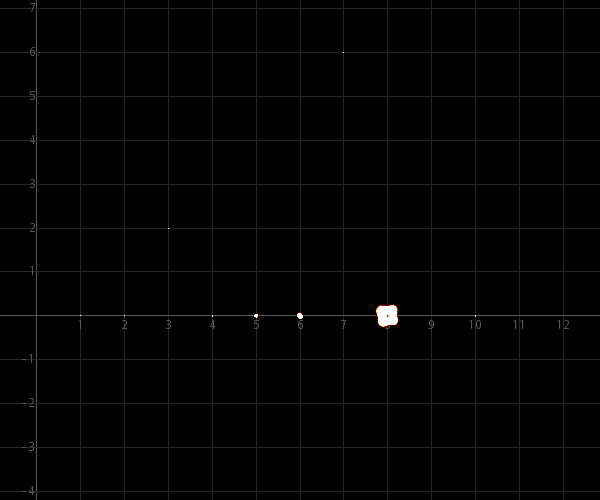
εmax = ½·10−6 :
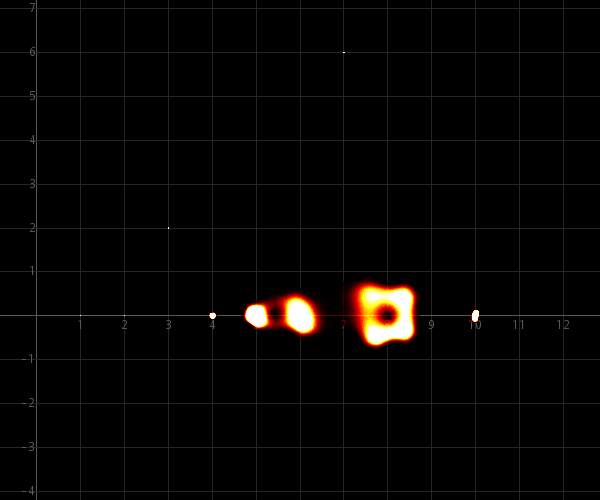
εmax = ½·10−5 :
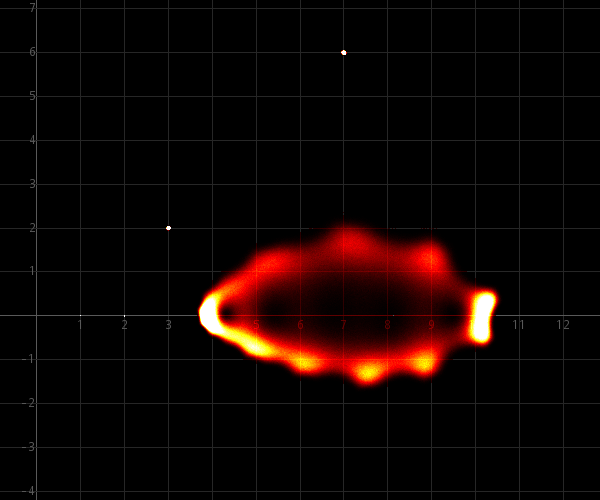
εmax = ½·10−4 :
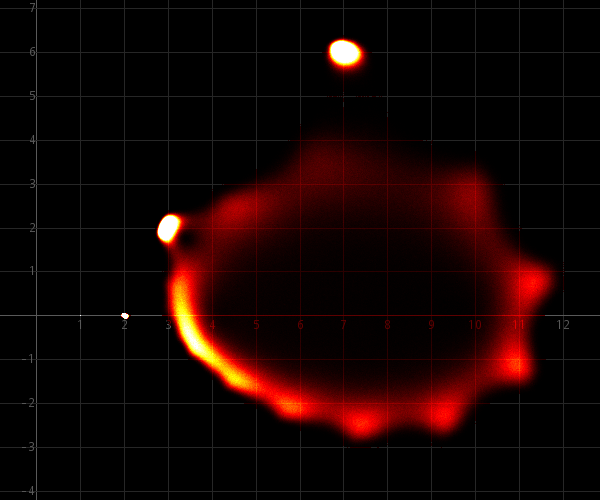
εmax = ½·10−3 :
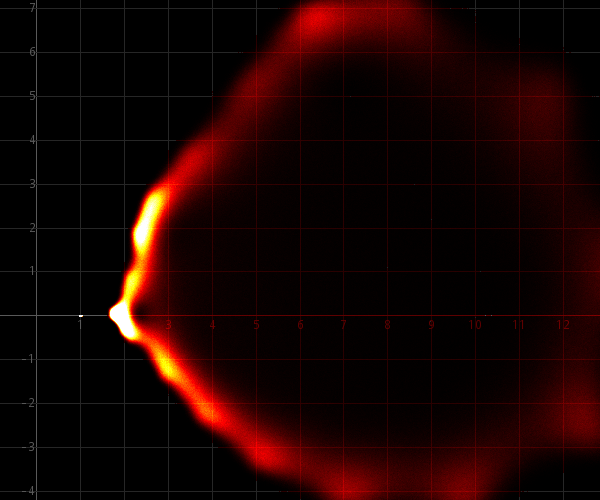
As these images demonstrate, the perturbed zeros are distributed more uniformly, but the difference is quite dramatic. This can be explained intuitively because for each coefficient, the perturbation space is a small 2-dimensional area, instead of a 1-dimensional part of a line. The effect will be a more fuzzy redistribution of roots.
Again, a video is made of this as well, again for 81 values of εmax ranging from ½·10−7 to ½·10−3, where the exponent goes from −7 to −3 in steps of 0.05. This video can be downloaded here. The computation of this video also required solving 1.62 billion 10th-degree polynomial equations and again, this takes nearly 70 minutes on an Intel Core i5, running at 3.4 GHz, in a single thread.
Random
perturbations from disk with certain small radius
In this final set of experiments
with random perturbations, the perturbations again are
of the form ai(1+εi), but now, the number εi is not a real number in a given interval [-εmax, εmax], but it is a
random complex number in a disk of radius εmax. The complex relative perturbation εi is determined by picking a random number ri
uniformly from the interval [0, ½εmax], and another random number ϕi picked
from the interval [0, 2π>.
The perturbation then is computed as
εi = ri ei ϕi = ri cos(ϕi) + i ri cos(ϕi)
With this perturbation, the
distribution of zeros looks quite different from the
above.
Again, multiple images are generated
for multiple values of εmax:
εmax = ½·10−7 :
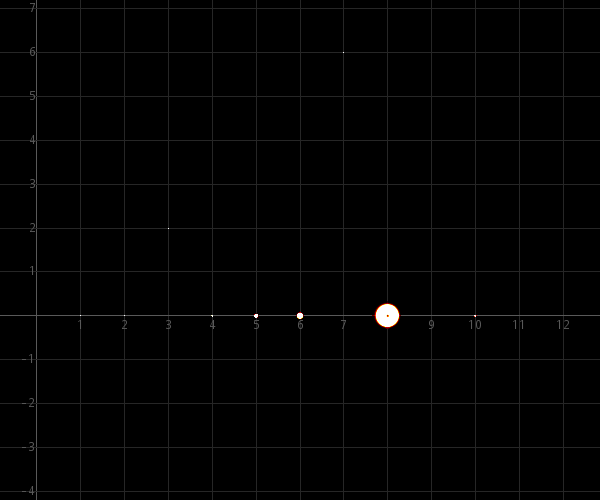
εmax = ½·10−6 :
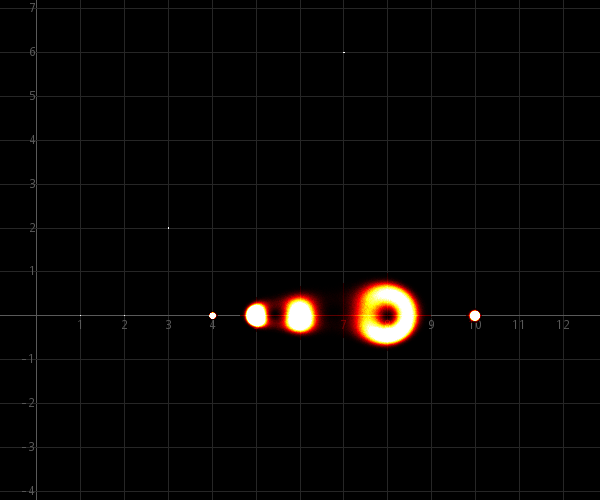
εmax = ½·10−5 :
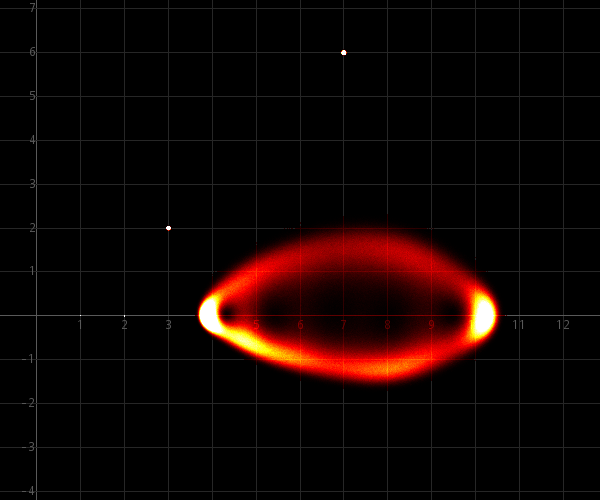
εmax = ½·10−4 :
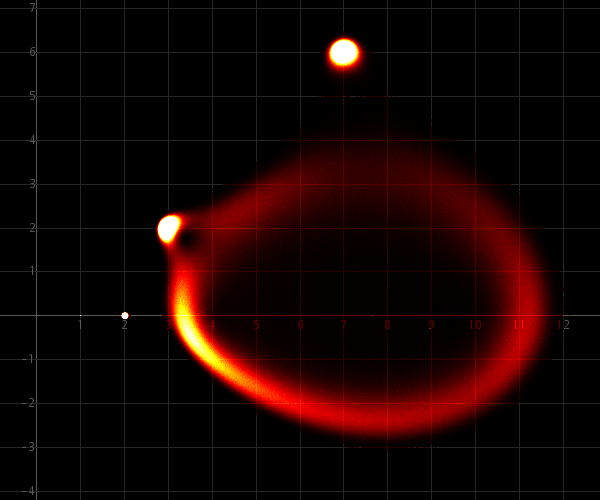
εmax = ½·10−3 :
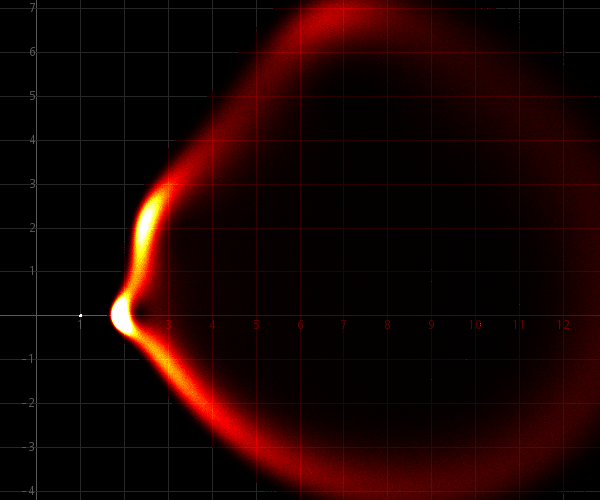
The perturbed
zeros are distributed even more uniformly as in the
previous experiment, but the difference is less
dramatic.
Again, a video is made of this as well, again for 81 values of εmax ranging from ½·10−7 to ½·10−3, where the exponent goes from −7 to −3 in steps of 0.05. This video can be downloaded here.
![]()
Distribution of roots of random
polynomials
When a random polynomial is taken,
with
completely random polynomials, then for increasing
degree of the
polynomial, the roots tend to converge to the unit
circle in the
complex plane and their distribution on the unit circle
tends to be
uniform. This is true for many kinds of distributions,
the requirements
on the distribution are very weak. This also is true for
many
polynomials with non-random coefficients.
In fact, it is quite hard to find a polynomial of high degree which does not have roots near the unit circle. One really has to construct polynomials in order to find other distributions. Below follows a typical picture of the zeros of a polynomial of degree 300 with random coefficients, taken uniformly from the interval [27, 42]:
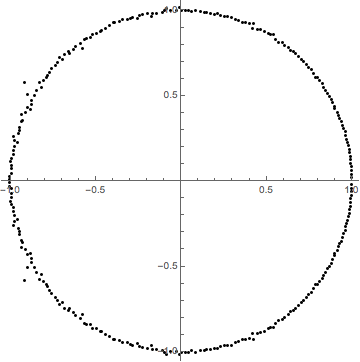
If a similar picture were made with coefficients, taken from e.g. [0, 100], [-10, 10], [30, 50] or even [-1000, 1000], then the result is very similar.
The following two figures show the effect of degree on the random roots. The higher the degree, the more the zeros approach the unit circle. The two figures below show zeros of several random polynomials of degree 10 and of degree 100, with coefficients taken at random uniformly from the filled square [-1,1]+i[-1,1] in the complex plane.
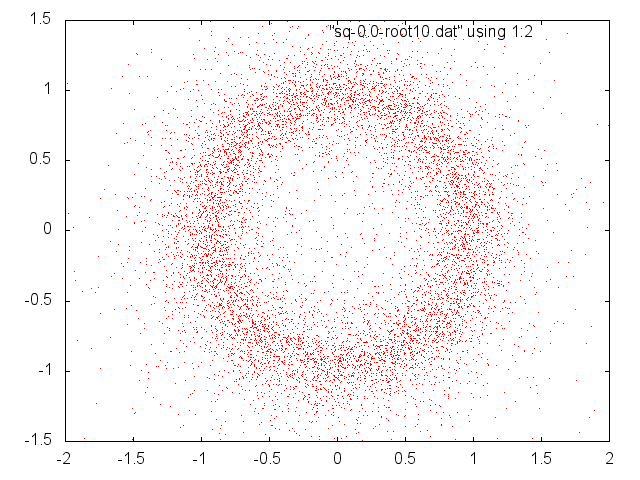
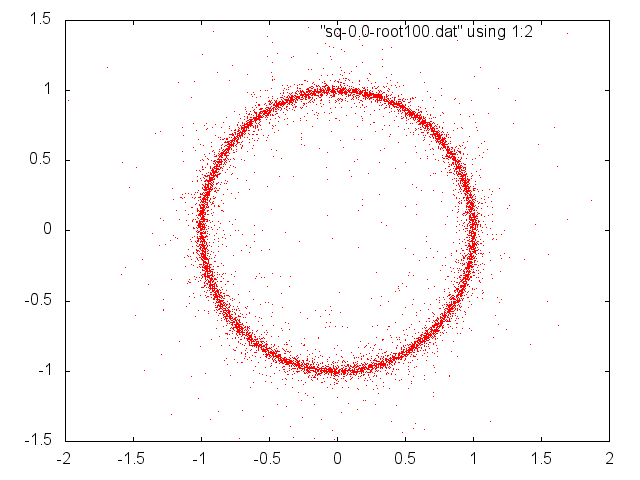
![]()
Inverse primorial polynomials
The section above shows that zeros tend to go to the unit circle for high degree polynomials. In this section, it is shown that other behavior can be constructed and quite interesting patterns emerge in this case. As a start, define the following analytic function on the complex plane:

Here, pk stands for the kth prime, and pk# stands for the kth prime primorial, which is defined as p1·p2 . . . ·pk. It is the product of the first k primes. Some examples:
p1# = 2
p2# = 2 · 3 = 6
p3# = 2 · 3 · 5 = 30
p4# = 2 · 3 · 5 · 7 = 210
. . . .
p8# = 2 · 3 · 5 · 7 · 11 · 13 · 17 · 19
The function ψ(x) is an analytic
function
on the entire complex plane. For people, who know of the
concept of
order and type of functions: it is an entire function of
order ρ=1 and type σ=1/e².
It grows exponentially fast for positive real x, at a
rate comparable to ex/e². For more info see https://en.wikipedia.org/wiki/Entire_function.
This function has infinitely many
complex
zeros distributed over the complex plane. Below, all
zeros in the
square from -10000 to 10000 in both real and imaginary
direction are
shown.
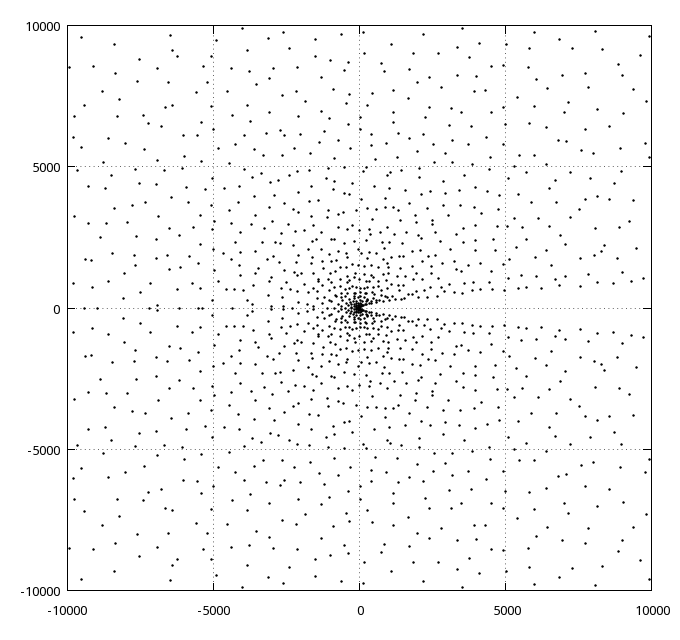
In the following image, all zeros in the square from -40000 to 40000 in both real and imaginary direction are shown.
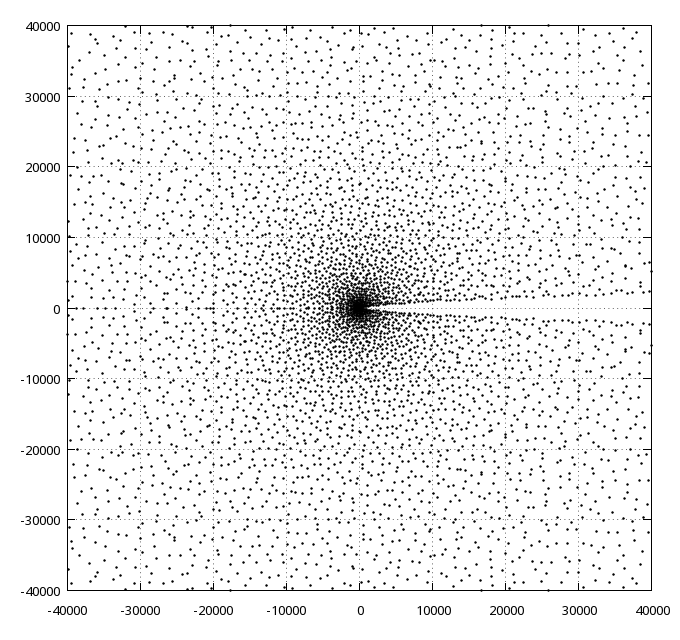
These plots show that the zeros seem
more
or less randomly distributed, with density decreasing
when the distance
from the origin increases and there is an empty area
around the
positive real axis, which has no zeros at all. This is
totally
understandable. The function ψ(x)
has
positive coefficients for all terms in its power series,
hence for any
positive real number it has a positive real value and
hence it has no
zeros on the real axis. In order to get from the big
positive real part
to a point where the real part can become zero one has
to move away
from the real axis more and more for increasing values
of x. This
explains the widening band of no zeros around the real
axis. The
function has many negative real zeros in the range from
−40000
to 0. The density of these also decreases with
increasing distance from
the origin. The graph of this function is a wildly and
irregularly
oscillating curve for negative real x, which occasionaly
goes through
the real axis.
The interesting thing is that approximating all these zeros from this analytical function can be done with the 2012 version of the MPSolve algorithm, by approximating zeros of different truncated power series. One series was truncated after power 7000 and the other after power 10000 and all zeros which are in both sets (within 12 digit accuracy) are genuine zeros.
A video demonstrates what happens when zeros of the truncated power series of ψ(x) are displayed, for polynomials of increasing degree. This video was created by rendering a plot of all the zeros of the nth degree truncated power series in an image file. Such an image file was generated for each n in the range 2, 3, 4, . . ., 1600. All these image files were combined into an animated gif file.
A similar video was made, but now all zeros of the nth degree truncated power series and all zeros of all lower degree truncated power series are accumulated into a single image and pixels are made hotter when they are touched more frequently. A pixel which is hit once is fairly dark red, a pixel which is hit several times becomes white hot. The genuine zeros will be hit many times for all truncated power series starting from a certain n. For each n in the range 2 . . . 1600 an image with all accumulated zeros is generated and these images again are put in an animated gif in order to obtain a playable video. This video shows intriguing patterns. There still is a lot to be investigated in the nature of these patterns.
It is best to watch these videos unscaled. When they are scaled, then many fine details are lost. They can be viewed without any pixel scaling on a monitor with 1080p resolution or better.
When one looks at the function ψ(x) or to the truncated power series of this then one is tempted to think of these as quite special functions, especially when one takes into account the tendency of high degree polynomials to have zeros close to the unit circle in the complex plane.
When one looks at the coefficients of the function ψ(x), then one sees that the coefficients have a certain growth rate. The growth rate of the reciprocal of the coefficients of power series of entire functions defines the order and type of entire functions. For this function, the growth rate is approximately like ee·n·ln(n). In an experiment, other functions were constructed at random, which have coefficients with similar growth rates in their denominator. This was done by using a recursive formula for the coefficients:




Here, rnd(n) is defined as follows: rnd(n) is a random number, taken uniformly from the interval [0, n>.
Using this set of coefficients, one
obtains an entire function, with a growth rate very
similar to the growth rate of function ψ(x). When the zeros of such a function are
determined, then the qualitative pattern is very similar
to the pattern for ψ(x).
Below are plots of all zeros combined in a single image
of a trunctated
power series of one such a random function, and 100 of
such random functions, each of these power series
truncated
after the 1000th power. Click on the images
below for a detailed high resolution view.
These images nicely show a distribution of zeros, very similar to the distribution of the zeros of ψ(x). Again, the zeros in the interior part of the image are genuine zeros, the zeros at the circular band of higher density near the border of the area with zeros are artifacts, due to truncation of the power series of the random functions.
These images also show that the function ψ(x) is not really special, it also demonstrates that the distribution of prime numbers and the rate of growth of prime numbers has a seemingly random component, which is very hard to distinguish from true randomness.
![]()
Roots of polynomials with 1 or −1
coefficients
There is no need to repeat the experiments on "the beauty of roots" webpage. Here, it is shown that many of the patterns do not depend on the degree of the polynomial. I.e. the fractally appearing patterns are the same for e.g. 20th degree polynomials, 30thdegree polynomials or 100th degree polynomials. This is a result, which nowhere else could be found on the internet and certainly is interesting to investigate in more detail. Proving this probably is not easy at all. For each of the four pictures below, the zeros of 2000000 polynomials were computed of degree 20, 30, 40, and 50. Each of the zeros were translated to a pixel position in the image and the pixel was made a little hotter. The leading coefficient for each of the polynomials was equal to 1, all other coefficients were taken randomly (50-50) from {−1, 1}.
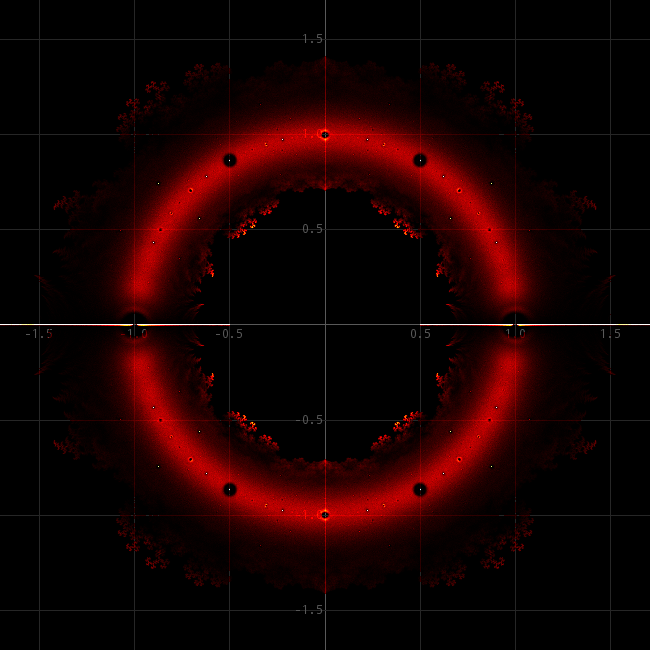

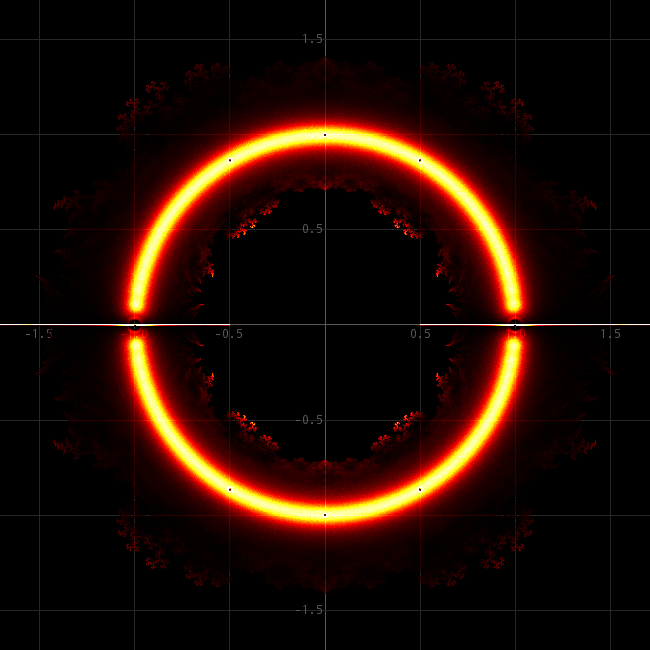
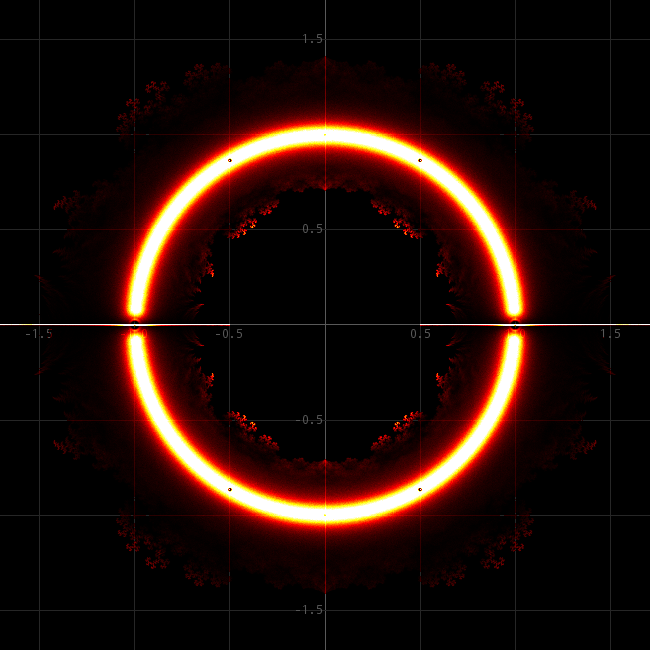
The pictures show that for increasing degree the number of very hot pixels increases. This is easy to explain, because of the fact that for an nth degree polynomial the total number of roots equals 2000000n. So, for higher n there are more roots to be used to make hot pixels.
What, however, is very peculiar is that further away from the unit circle |z|=1 there are interesting fractal patterns and these are (at the resolution of these images) the same for all four images. The density of zeros (the temperature of the pixels) is much higher for 50th degree polynomials close to the unit cicrle, but further away from the unit circle, the density of zeros seems to be independent of the degree of the polynomial. This is remarkable. Intuitively, one would expect the density of zeros to be larger everywhere. But even more remarkable is that for the higher degree polynomials not only the density is the same further away from the unit circle, but also their distribution of roots over the complex plane is VERY close for different degrees.
Apparently, the zeros of polynomials with coefficients taken randomly from {−1, 1} are positioned at specific places when they are somewhat further from the unit circle. E.g. at and around 0.55 + 0.45i there are no zeros, not for any polynomial of this type and around 0.42 + 0.5i there is the same fractal pattern, regardless of degree of the polynomial.
Click this link for a beautiful picture of 2000000 roots of a 100th degree polynomials at high resolution. It took approximately 80 minutes to compute this picture, using 105 bits double double precision in Java on a quad core Intel I5 running at 3.4 GHz. It shows exactly the same fractal patterns inside the unit circle and outside the unit circle as the four pictures above and has a very hot band around the unit circle.
